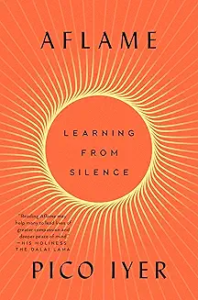Aflame: Learning from Silence by Pico Iyer 2025
Iyer is one of those extraordinary writers who are difficult to label. Is he a travel writer, a literary critic, a novelist, an essayist, a philosopher, a Zen Buddhist monk, or some combination. In “Aflame”, his 17th book, there are all of these elements combined into a rich meditation on time, death, life, the tension between solitude and community, and the need to find silence and solitude in order to understand one’s self.
Iyer, born in India and raised in Central Coastal California, began earning his world traveler credentials with degrees at Oxford and Harvard before working as a travel correspondent for Time. He currently lives in Santa Barbara and Japan.
This book is a powerful and beautifully written collection of thoughts and experiences largely untethered to time but not to place. There is precious little specific information about time (dates don’t appear anywhere in the text) and just a bit more about place, specifically the Cameldolese order monastery he first discovered 30 years ago after his house in California burned down with all of his possessions. We learn that the Cameldolese order of the Benedictines was founded in 1012 by St. Rounald, and the Hermitage in Big Sur was founded as a branch in 1958, but Iyer’s visits there over the years are recounted in random order in the book.
What is clear is that the solitude amongst the very basic, elemental living conditions in the monestary was critically important for him to get grounded while dealing with personal losses and challenges—the loss of two homes to fire, the death of his parents, his marriage to a Japanese woman who had children one of whom became very ill. All of these life events were processed by him in his solitude in Big Sur enabling him to read and channel important writers in his life. Dickinson, Pascal, Henry Miller, Marcus Aurelius, Thoreau, Thomas Merton, Robinson Jeffers, Milton, Camus, Admiral Byrd, George Saunders, and especially the Zen Buddhist monk, singer, writer, and philosopher Leonard Cohen with whom he had a strong friendship all make an appearance and are drawn into his contemplation of life, death, and the tension between solitude and community. Similarly, his experiences in La Paz, Bogota, Ethiopia, Haiti, Vietnam, Singapore, Easter Island, and Japan all find a way into his silent contemplation.
His descriptions of the land, the monastery, and the monks are powerfully effective. Here’s Iyer on the monastery: “But still I feel I’m in some rough and uncared-for, all male B and B. Not the great seagoing vessel that is my life in the expanse outside; rather the boiler room behind the scenes where men in blue work clothes are laboring night and day to keep the vessel in motion.” And here’s Iyer on the central issue in his book: “How to prepare for death? It becomes a central question in any monastery, and one without an answer. I spend time with monks and nuns, I realize, because they’re giving themselves full-time to the essential practices: learning how to love in the midst of loss. And how to hope in the face of death.” As the book nears its end, Iyer quotes Admiral Byrd who spent weeks in solitude in Antarctica and who wrote in his memoir “Alone” “It is surprising approaching the final enlightenment, how little one really has to know or feel sure about.” Finally, in what may be his final take on silence and solitude, Iyer quotes one of Kafka’s riddles: “You do not need to leave your room. Remain sitting at your table and listen. Do not even listen, simply wait, be quiet, still and solitary. The world will freely offer itself to you to be unmasked; it has no choice. It will roll in ecstasy at your feet.”
I’ve read other Iyer books and heard him in conversation with a neuroscientist at Dartmouth last year. He’s a fascinating character, an international citizen, and a deep thinker and writer who puts into words on the page the thoughts and internal struggles that all of us have as we deal with real life and contemplate the inevitable end of it. Worth reading.



